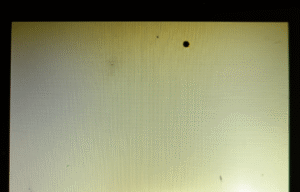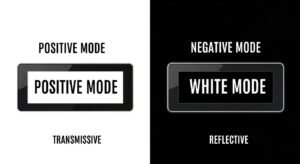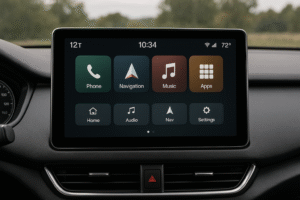
Many people struggle to understand why their display’s colors sometimes look off. I often meet clients confused about “color depth.” Let’s solve that confusion together.
Color depth means the number of unique colors a display can show. More color depth gives smoother gradients and more realistic images, which is critical for LCD displays.
I used to think all screens showed color the same way until I handled different projects for clients. Now, I know color depth is often the “invisible” feature that makes or breaks display quality.
What is Color Depth?

Color depth often appears in display specs, but what does it mean?
Color depth is the number of bits used to describe the color of a single pixel. More bits mean more possible colors, so the image looks more vibrant and accurate.
Why Is Color Depth Important?
| Color Depth (bits) | Number of Colors |
|---|---|
| 1 | 2 |
| 4 | 16 |
| 8 | 256 |
| 16 | 65,536 |
| 24 | 16,777,216 |
Understanding Bits per Pixel (bpp)?
Bits per pixel (bpp) shows how many bits are used for each pixel’s color. More bpp means more color choices for each pixel, allowing for richer images.
How bpp Works in Real Displays
I often get questions about “bpp” in data sheets. When you see “16bpp,” it means every pixel uses 16 bits to describe its color.
For a typical 16bpp display (often called 65K color), each color channel (Red, Green, Blue) uses a set number of bits, usually 5 for Red, 6 for Green, 5 for Blue(What Exactly Are DPI and PPI, and Why Do They Derail Design Projects?).
Here’s how it usually breaks down:
| bpp | Red (bits) | Green (bits) | Blue (bits) | Total Colors |
|---|---|---|---|---|
| 8 | 3 | 3 | 2 | 256 |
| 16 | 5 | 6 | 5 | 65,536 |
| 24 | 8 | 8 | 8 | 16,777,216 |
When I worked with a client building a ebike dashboard, using a higher bpp meant their screen could show more realistic weather icons and gradient backgrounds. This made their product stand out.
How Does Color Depth Affect Image Quality?
Does color depth really make a difference in what you see?
Higher color depth removes visible color banding and makes images appear smoother and more natural. Low color depth can make images look unnatural or “blocky.”
Real-World Effects of Color Depth
I’ve seen projects where a beautiful product design loses impact due to low color depth. Here’s what can happen at different levels:
Banding vs. Smooth Gradients
- Low color depth (8-bit): You might see banding, where colors jump from one shade to another.
- High color depth (24-bit): Gradients look seamless, skies look natural, and small details become visible.
Visual Differences at Different Color Depths
| Color Depth | Common Use Case | Image Quality |
|---|---|---|
| 8-bit | Old devices, icons | Strong banding |
| 16-bit | Simple graphics | Light banding |
| 24-bit | Photos, videos | Smooth transitions |
| 30-bit+ | Medical, pro graphics | Best color accuracy |
I learned this first-hand when I tested the same image on two sample modules. The 24-bit module gave much better skin tones and sunset colors.
8-bit vs. 10-bit vs. 16-bit vs. 24-bit
How does each step up in color depth change what you see?
Moving from 8-bit to 24-bit greatly increases the number of colors and smoothness. Each step up reduces color banding and improves color accuracy, especially in gradients.
Breaking Down the Differences
Bit Depth and Number of Colors
| Bit Depth | Total Colors | Typical Use |
|---|---|---|
| 8-bit | 256 | UI, icons, simple displays |
| 10-bit | 1,024 (per channel) | High-end photography, HDR monitors |
| 16-bit | 65,536 (per channel) | Medical, industrial, color grading |
| 24-bit | 16.7 million | Most modern LCD screens |
Use Case Scenarios
- 8-bit: Fast, low-memory uses; limited color range.
- 10-bit: Better for photo/video editing.
- 16-bit: Required for high-precision needs.
- 24-bit: Standard for realistic images and videos.
I remember working with a client who wanted to upgrade their display from 8-bit to 16-bit. The difference was night and day—their new dashboards showed color maps that finally looked right.
True vs. Emulated Color Depth
Is your display really showing all those colors, or is it “faking” some of them?
True color depth means the hardware can display all colors at once. Emulated color depth uses software tricks like dithering to mimic higher depth but can’t show all colors at once.
What Happens in Practice?

How Emulation Works
Some displays use 6-bit panels but claim “16.7 million colors.” They achieve this through “dithering” or “Frame Rate Control (FRC),” switching between colors fast to fool the human eye.
True vs. Emulated Color Depth
| Type | How it Works | Pros | Cons |
|---|---|---|---|
| True | Hardware supports all colors | Real accuracy | Costs more, more power |
| Emulated | Uses software (dithering/FRC) | Cheaper, flexible | May show flicker, artifacts |
Once, I had a client confused why their “16.7M color” screen didn’t match samples from another supplier. It turned out the first was emulated, the second was true. The difference was clear in side-by-side testing, especially in smooth gradients.
How to Choose the Right Color Depth for Your Use Case?
Consider your application’s needs, device cost, and customer expectations. For basic text and icons, 8- or 16-bit can work. For photos or medical use, 24-bit or higher is best.
Matching Color Depth to Use Case
Key Factors to Consider
- Application Type: Photo, video, or just text?
- Memory and Processing Power: Higher color depth needs more data.
- User Expectations: Will users notice small color errors?
- Budget: Higher color depth can increase costs.
Color Depth by Application
| Application | Suggested Color Depth |
|---|---|
| Wearable device UI | 8- or 16-bit |
| Industrial control panel | 16-bit |
| Consumer device screens | 24-bit |
| Medical imaging | 24-bit or higher |
My Own Experience
One of my clients, an assembly factory, switched to 24-bit modules for their new smart home display. The screens looked far more impressive in their trade show demo, and their clients noticed the improvement right away.
Conclusion
Color depth shapes the way images look on any LCD display. Choosing the right depth gives your product the best visual results.
Related Articles:
How to Design Your Own Segment LCD?
What Is the Difference Between Capacitive and Resistive Touch Screens?
What Is the Difference Between Static and Dynamic Contrast Ratio?
What is the difference between OLED and AMOLED? What are its advantages?
What Are the Differences Between VCC, VDD, VSS, and VEE in LCD Power Inputs?
FAQ
Will higher color depth slow down my device?
Higher color depth may use more memory, but modern devices usually handle 16-bit and 24-bit displays smoothly without noticeable slowdowns.
Is 8-bit color depth enough for simple industrial applications?
Yes. For basic icons or text, 8-bit can be enough, but for clear graphics or small details, 16-bit or 24-bit is better.
Can color depth affect power consumption?
Higher color depth may slightly increase power use, but other display factors (like backlight) usually have a bigger impact.
Are there visual issues with emulated color depth?
Yes, emulated color depth can show banding or flicker in gradients, especially with moving images or detailed graphics.
What is the difference between color depth and resolution?
Color depth determines how many colors a display can show, while resolution defines how many pixels make up the image. Both affect quality—color depth impacts color accuracy, and resolution affects sharpness.








